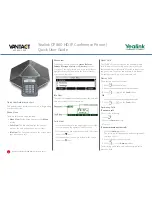
28
I’m not getting reception — the channel lights on the receiver are red. What’s wrong?
• Check that the transmitter is on and is un-muted
• Verify that you are not blocking either the emitters on the transmitter or the sensors on receiver or
mounted around room
• If reception is interrupted when facing a certain direction, install an additional sensor in that area of
the room
• If team-teaching, verify that transmitters are not on the same channel
• Recharge transmitter’s batteries if low battery indicator shows. Replace batteries if recharge is ineffective.
I’m getting feedback (squealing) — how can I minimize this?
• Make sure that speakers are mounted as close as possible to both the ceiling and the listeners; avoid mounting
speakers in the teacher’s primary lecture area (see
Step 2
)
• Position the microphone closer to mouth
• Lower the
M
ic
V
oluMe
control(s) on the receiver
• Select the Low or Medium
o
Pti
V
oice
setting
There’s no sound coming out of the speakers (or it’s weak)
• Verify that the receiver is on (green power light)
• Verify that the receiver is picking up a signal (green channel indication light)
• Increase the
M
ic
V
oluMe
or
a
ux
V
oluMe
control(s) on the receiver
• Position the microphone closer to mouth
• Verify that the speaker cables are connected properly
• Verify that the transmitter is not muted
My receiver won’t turn on — the power light is off. What should I do?
• Verify that the power supply is plugged into both the receiver and a working wall outlet
• Test with another power supply
The power light turned yellow
• The receiver is in STANDBY mode. The power button will turn yellow in STANDBY mode.
• The receiver will power-down automatically when it does not detect a microphone or audio input for more
than 10 minutes.
• The receiver will turn on automatically when:
– You turn on and/or un-mute a microphone
– You turn on an audio source connected to the receiver
How can I eliminate ’dead spots’ or microphone crackling / noise?
• Verify that you are not blocking either the emitters on the transmitter or the sensors on receiver or
mounted around room
• If reception is interrupted when facing a certain direction, install an additional sensor in that area of the
room (see
Step 2
)
• If team-teaching, verify that transmitters are not on the same channel
• Recharge or replace the transmitter’s batteries
• Verify that the emitter/mic is working (test with another working emitter/mic)
Why do I need to install external sensors?
Your FrontRow Pro Digital system uses infrared light to transmit your voice from the transmitter to the
receiver, similar to how your remote control changes your TV channels. This light signal needs to either be
direct (i.e., ‘line of sight’) or reflected off walls, ceiling, and other surfaces. While in many cases, the sensor
that’s built into the receiver is more than adequate, some classrooms don’t have enough reflective surfaces to
allow the teacher to turn away from the receiver or stand in certain parts of the room. That’s why it’s a good
idea to add at least one external sensor.
I think I need more than four speakers. Can I?
Yes. You can add up to 6 speakers (8
Ω
only) . See Special Speaker Connections (page 29)
Appendix C:
Troubleshooting



































